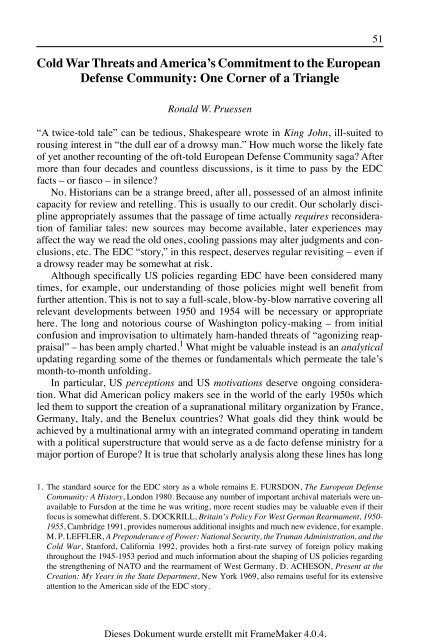journal of european integration history revue d'histoire de l ...
journal of european integration history revue d'histoire de l ...
journal of european integration history revue d'histoire de l ...
Create successful ePaper yourself
Turn your PDF publications into a flip-book with our unique Google optimized e-Paper software.
Cold War Threats 51<br />
Cold War Threats and America’s Commitment to the European<br />
Defense Community: One Corner <strong>of</strong> a Triangle<br />
Ronald W. Pruessen<br />
“A twice-told tale” can be tedious, Shakespeare wrote in King John, ill-suited to<br />
rousing interest in “the dull ear <strong>of</strong> a drowsy man.” How much worse the likely fate<br />
<strong>of</strong> yet another recounting <strong>of</strong> the <strong>of</strong>t-told European Defense Community saga? After<br />
more than four <strong>de</strong>ca<strong>de</strong>s and countless discussions, is it time to pass by the EDC<br />
facts – or fiasco – in silence?<br />
No. Historians can be a strange breed, after all, possessed <strong>of</strong> an almost infinite<br />
capacity for review and retelling. This is usually to our credit. Our scholarly discipline<br />
appropriately assumes that the passage <strong>of</strong> time actually requires reconsi<strong>de</strong>ration<br />
<strong>of</strong> familiar tales: new sources may become available, later experiences may<br />
affect the way we read the old ones, cooling passions may alter judgments and conclusions,<br />
etc. The EDC “story,” in this respect, <strong>de</strong>serves regular revisiting – even if<br />
a drowsy rea<strong>de</strong>r may be somewhat at risk.<br />
Although specifically US policies regarding EDC have been consi<strong>de</strong>red many<br />
times, for example, our un<strong>de</strong>rstanding <strong>of</strong> those policies might well benefit from<br />
further attention. This is not to say a full-scale, blow-by-blow narrative covering all<br />
relevant <strong>de</strong>velopments between 1950 and 1954 will be necessary or appropriate<br />
here. The long and notorious course <strong>of</strong> Washington policy-making – from initial<br />
confusion and improvisation to ultimately ham-han<strong>de</strong>d threats <strong>of</strong> “agonizing reappraisal”<br />
– has been amply charted. 1 What might be valuable instead is an analytical<br />
updating regarding some <strong>of</strong> the themes or fundamentals which permeate the tale’s<br />
month-to-month unfolding.<br />
In particular, US perceptions and US motivations <strong>de</strong>serve ongoing consi<strong>de</strong>ration.<br />
What did American policy makers see in the world <strong>of</strong> the early 1950s which<br />
led them to support the creation <strong>of</strong> a supranational military organization by France,<br />
Germany, Italy, and the Benelux countries? What goals did they think would be<br />
achieved by a multinational army with an integrated command operating in tan<strong>de</strong>m<br />
with a political superstructure that would serve as a <strong>de</strong> facto <strong>de</strong>fense ministry for a<br />
major portion <strong>of</strong> Europe? It is true that scholarly analysis along these lines has long<br />
1. The standard source for the EDC story as a whole remains E. FURSDON, The European Defense<br />
Community: A History, London 1980. Because any number <strong>of</strong> important archival materials were unavailable<br />
to Fursdon at the time he was writing, more recent studies may be valuable even if their<br />
focus is somewhat different. S. DOCKRILL, Britain’s Policy For West German Rearmament, 1950-<br />
1955, Cambridge 1991, provi<strong>de</strong>s numerous additional insights and much new evi<strong>de</strong>nce, for example.<br />
M. P. LEFFLER, A Prepon<strong>de</strong>rance <strong>of</strong> Power: National Security, the Truman Administration, and the<br />
Cold War, Stanford, California 1992, provi<strong>de</strong>s both a first-rate survey <strong>of</strong> foreign policy making<br />
throughout the 1945-1953 period and much information about the shaping <strong>of</strong> US policies regarding<br />
the strengthening <strong>of</strong> NATO and the rearmament <strong>of</strong> West Germany. D. ACHESON, Present at the<br />
Creation: My Years in the State Department, New York 1969, also remains useful for its extensive<br />
attention to the American si<strong>de</strong> <strong>of</strong> the EDC story.<br />
Dieses Dokument wur<strong>de</strong> erstellt mit FrameMaker 4.0.4.

















